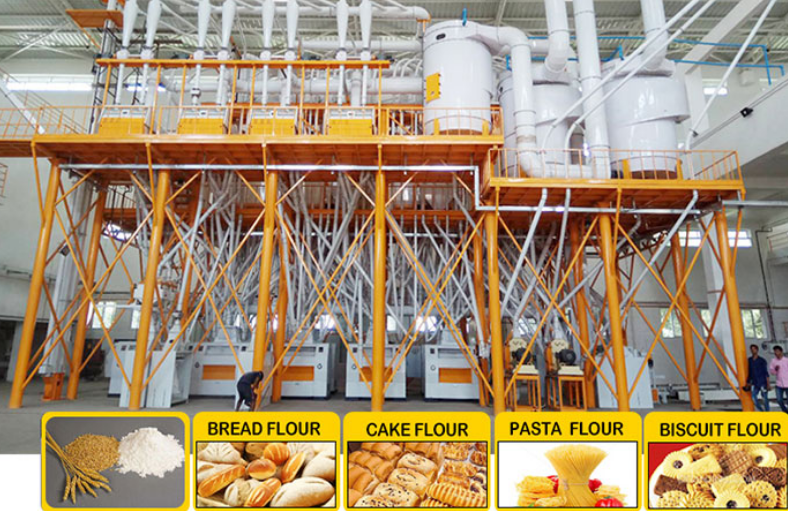Despite the abundance of flour mills in the market, the high demand for various types of flour makes starting a flour processing business with small and medium-sized mills still profitable. In recent years, continuous research and development in science and technology have led to significant advancements in flour processing equipment. These improvements in production technology and product structure not only meet the actual production needs of users but also enhance grain processing machinery. As a result, the market now exhibits diverse processing trends.
If you are interested in starting a wheat flour milling business, understanding how a fully automatic wheat flour mill works will help you to run your wheat flour milling investment plan smoothly.

Extensive enterprise experiments have proven that automatic wheat flour milling equipment can process not only wheat but also corn, sorghum, soybeans, and other grains, making it suitable for small and medium-sized flour processing plants. This fully automatic equipment features a reasonable design that overcomes the limitations of traditional methods. The milling process includes split, skin, and core grinding, which enhances flour quality. Additionally, it has low workshop requirements, low power consumption, high output, and convenient maintenance. Compared to traditional equipment, it offers higher production efficiency, thereby increasing the overall income of the enterprise.
Pingle Machinery's flour milling equipment avoids the high energy consumption of traditional machines by using new energy-saving technology, resulting in low unit energy consumption. Depending on the volume of flour production, the equipment can be categorized into large wheat flour mills and medium flour mills.
Pingle Machinery's flour processing machinery can produce both ordinary and standard flour, making it ideal for individual small flour processing mills as well as large flour milling plants. The equipment features small investment requirements, quick returns, and easy operation. If you are interested in setting up a wheat flour mill, please click the button below to contact us.
Processing wheat into flour using milling equipment typically involves six key steps:
1. Cleaning: The wheat is washed to remove impurities such as sticks, stones, and other coarse and fine materials. The cleaned wheat is then sent to conditioning boxes for further processing.
2. Tempering and Conditioning: The wheat is soaked in water to facilitate bran removal. Conditioning ensures even moisture content throughout the grain, which helps prevent the bran (outer layer) from cracking during grinding.
3. Grinding: Conditioned and cleaned wheat is mixed and ground together. Different batches of wheat are combined at this stage to produce the desired type and quality of flour.
4. Separation: The ground mixture of bran and endosperm is separated by filtration through a round sieve to isolate the bran from the endosperm.
5. Milling: The wheat is ground into smaller pieces by a mill. It is then passed through a sieve, and through repeated grinding and sieving, it is transformed into fine flour, wheat germ, and bran.
6. Blending: Different flours are blended together to produce various types of flour. For example, whole wheat flour is made by combining wheat bran and white flour.
Implementing fully automatic flour processing equipment offers numerous benefits for flour processing enterprises. It significantly reduces the need for human resources and cuts production costs, which is advantageous for future production expansion and business growth. The superior performance of fully automatic flour machines enhances both the quality of flour and production efficiency. This advancement heralds a new era in flour processing equipment, paving the way for an innovative and competitive flour processing market.
Fully automatic | one person operation, one machine for multiple purposes, automatic feeding, automatic noodles. |
Multi-purpose | can process wheat, corn, beans, rice and other raw materials. |
High speed | One motor is used in the whole machine, and the output is 10 times that of the stone flour mill. |
Low temperature processing, original taste | starch will not be gelatinized due to high temperature curing, vitamins and trace elements will not be destroyed, and nutrients still exist. |
The automatic wheat flour machine holds great potential in the grain equipment market, which is developing steadily. During processing, the automatic equipment eliminates the need for manual feeding, transporting the grain directly to the mill for grinding via pipelines. This greatly enhances production efficiency, shortens working time, and improves processing output.
Given the complex milling process and advanced machinery involved, large-scale flour mill projects require substantial investment. If you plan to start a flour mill business, choosing high-quality automatic wheat flour milling equipment is essential. A reliable flour equipment supplier can assist you in developing a complete and viable business plan. Please contact us for more details!
Copyright © Hebei Pingle Grain Technology Intelligent Equipment Co.ltd. All Rights Reserved | Sitemap | Technical Support: 